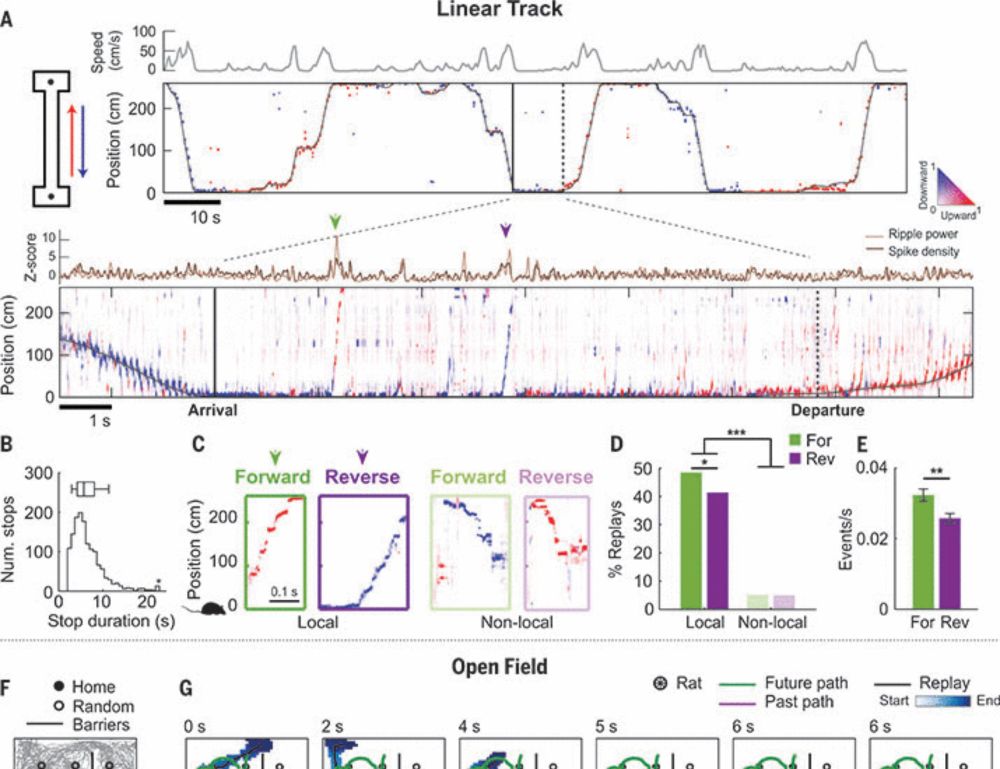
1/19 I’m thrilled that my postdoctoral work, with John Widloski and David Foster is now out in @science.org, along with a wonderful preview by Daniel Bendor!
31.01.2025 21:14 — 👍 159 🔁 48 💬 9 📌 3@t-elston.bsky.social
Assistant Prof. at U.T. Austin • NHP + Human ephys and cognition • #Humboldtian • elstonlab.org formerly UC Berkeley, Tübingen, and Otago

1/19 I’m thrilled that my postdoctoral work, with John Widloski and David Foster is now out in @science.org, along with a wonderful preview by Daniel Bendor!
31.01.2025 21:14 — 👍 159 🔁 48 💬 9 📌 3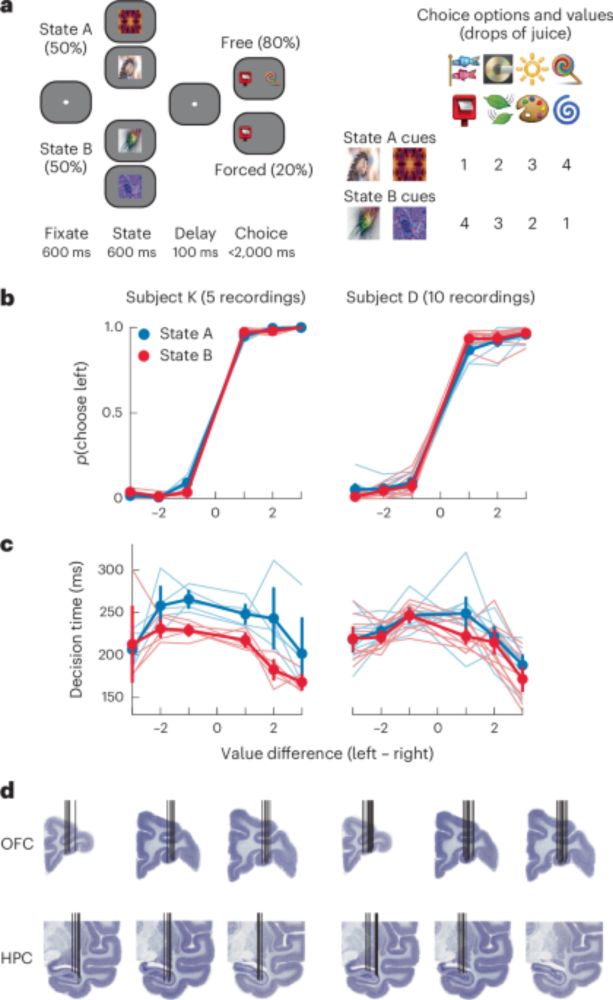
Pleased to share the final version (out in @natureneuro.bsky.social ) of my recent project showing how the primate HPC and OFC interact during contextual reasoning!
www.nature.com/articles/s41...
A big thanks to the reviewers who made the paper better!

A farewell dim sum dinner with my Berkeley crew. On the one hand, I am so excited to start my lab in Austin; on the other, I'm also so thankful for the friends and colleagues who truly helped me feel so at home these last few years 🥲
08.12.2024 07:49 — 👍 3 🔁 0 💬 0 📌 0any chance the dept. is open to a primate user?
24.09.2023 17:16 — 👍 0 🔁 0 💬 1 📌 0Marmosets!
16.09.2023 16:46 — 👍 2 🔁 0 💬 0 📌 0Definitely yes, although it feels like behavior alone needs now to be part of a neuropipeline. I do pure behavior in people to ID tasks/effects which I'll then characterize neurophysiologically in primates. Still, without convincing/cool behavior, it's not worth looking at the brain
16.09.2023 16:45 — 👍 1 🔁 0 💬 1 📌 0whale?
16.09.2023 16:30 — 👍 0 🔁 0 💬 0 📌 0
Looks like a great paper on the 𝗵𝗶𝗽𝗽𝗼𝗰𝗮𝗺𝗽𝘂𝘀 𝘄𝗶𝘁𝗵 𝗰𝗼𝗺𝗽𝗮𝗿𝗶𝘀𝗼𝗻𝘀 𝗯𝗲𝘁𝘄𝗲𝗲𝗻 𝗵𝘂𝗺𝗮𝗻𝘀 𝗮𝗻𝗱 𝗻𝗼𝗻-𝗵𝘂𝗺𝗮𝗻 𝗽𝗿𝗶𝗺𝗮𝘁𝗲𝘀. Goes to show that "conservation" is a very complex, subtle issue.
www.biorxiv.org/content/10.1...

Now out in Cell Reports! @janzimmermann.bsky.social
www.sciencedirect.com/science/arti...
loved the first one, for sure
10.09.2023 07:43 — 👍 1 🔁 0 💬 0 📌 0A similar line of reasoning could be applied to credit-assignment during learning - distinct value sub-circuits for each state could make it easier to understand why an outcome occurred in one scenario without affecting the other. [13/n]
10.09.2023 00:58 — 👍 0 🔁 0 💬 0 📌 0Why would OFC have state-specific subcircuits for value? I think it's to facilitate cognitive control. In the task, a low value opt in state A is a high value opt in state B. A single subcircuit could have conflict as to which value to assign. Subcircuits side-step that. [12/n]
10.09.2023 00:58 — 👍 0 🔁 0 💬 0 📌 0What does this imply? 1: HPC initially constructs/sets the cognitive map; OFC uses the cognitive map to guide choice. 2: There is no "common currency" for value in the OFC (as was widely believed). 3: Cognition arises via rhythmic interactions between brain areas. [11/n]
10.09.2023 00:58 — 👍 0 🔁 0 💬 0 📌 0Taken together, these results suggest that HPC initially encodes state as it becomes available and then relays that to OFC via theta coherence. This has the effect of activating distinct, state-specific subcircuits for value, thus allowing for contextual reasoning in value-based choice. [10/n]
10.09.2023 00:57 — 👍 0 🔁 0 💬 0 📌 0This indicates that distinct subcircuits within the OFC encode value within each task state and suggests OFC value coding is far more flexible than previously thought. Interestingly, HPC neurons generalized their value code across task-states. [9/n]
10.09.2023 00:57 — 👍 0 🔁 0 💬 0 📌 0
OFC neurons famously encode value. Does OFC's value code generalize across task-states? Turns out, no! I regressed each neuron's firing rates against value for choices in each state, and then correlated the betas. Most OFC neurons encoded value in only one state! [8/n]
10.09.2023 00:56 — 👍 0 🔁 0 💬 0 📌 0So far, this suggests that HPC encodes state information as it becomes available and then may relay that information to OFC via theta coherence. But what happens when state information arrives in OFC? [7/n]
10.09.2023 00:56 — 👍 0 🔁 0 💬 0 📌 0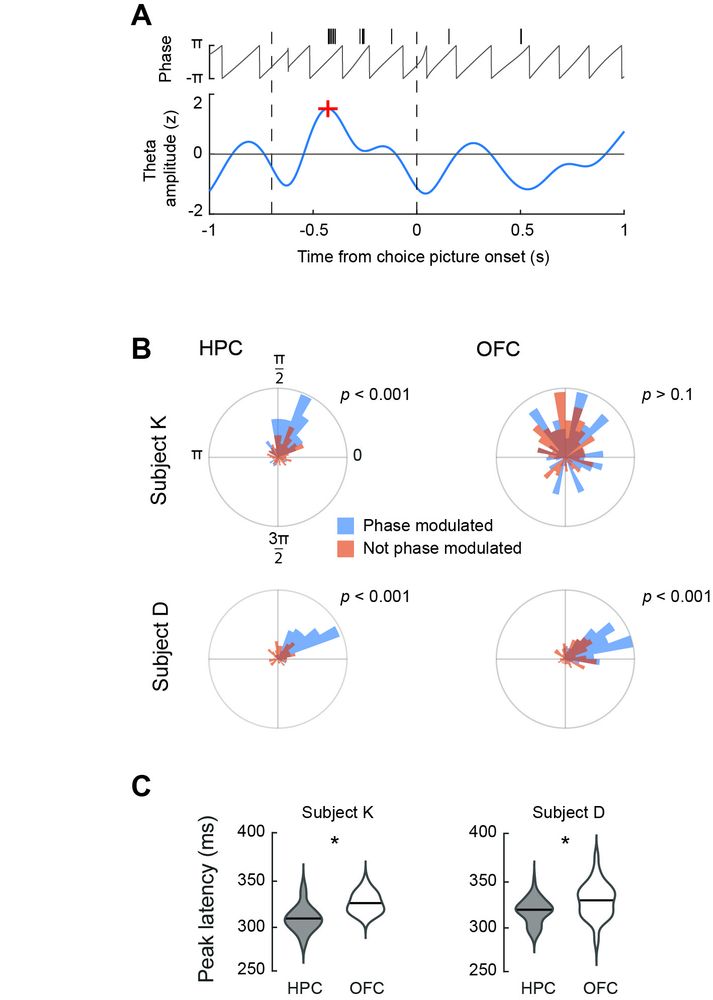
Several lines of evidence suggest HPC is the sender: HPC neurons were phase-locked to the rising phase of theta and single-trial HPC theta amplitude peaks preceded those in OFC. Partial directed coherence models also suggested HPC->OFC directionality. [6/n]
10.09.2023 00:56 — 👍 0 🔁 0 💬 0 📌 0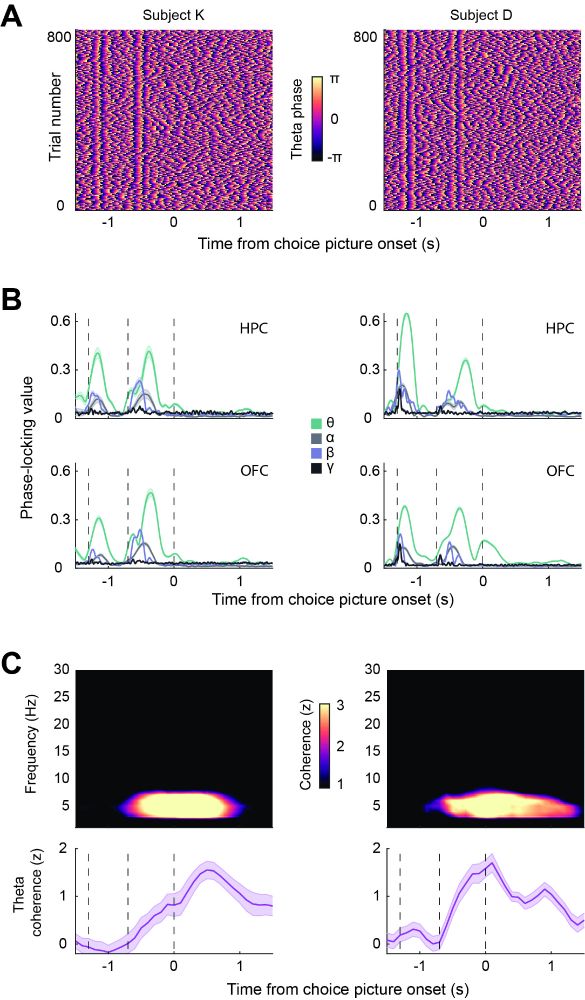
HPC and OFC are strongly connected and next I wanted to see if they communicate. LFP Theta (4-8 Hz) responses were present on every trial and HPC-OFC theta coherence ramps, starting at the state cue and peaking at the choice, suggesting that HPC and OFC are communicating. [5/n]
10.09.2023 00:55 — 👍 0 🔁 0 💬 0 📌 0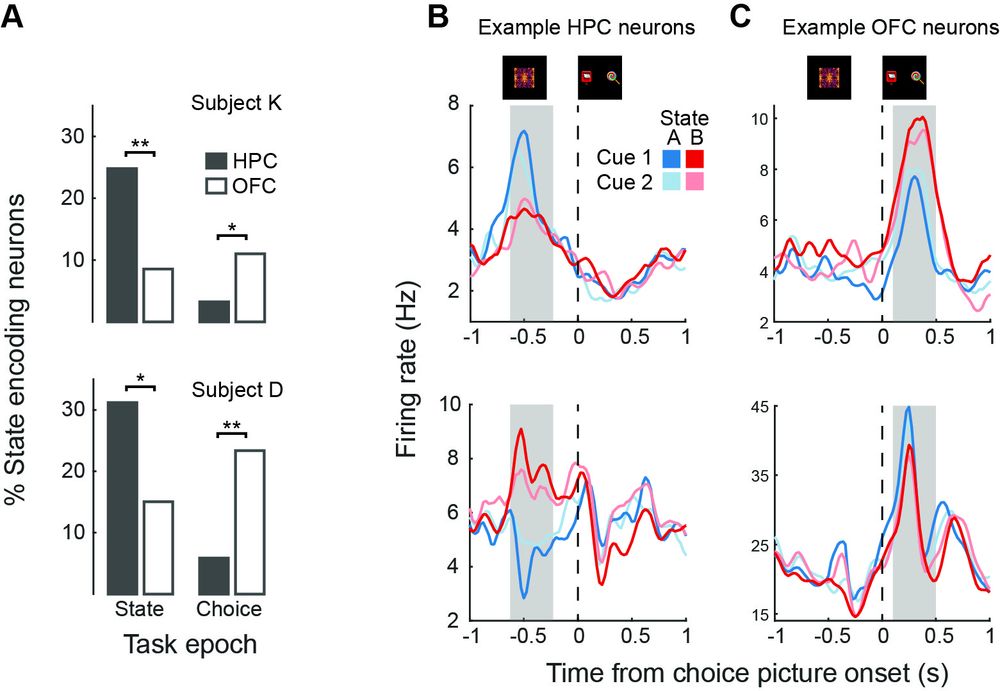
I found a functional double-dissociation between HPC and OFC: HPC (but not OFC) neurons encode state information as it becomes available and, at the choice, OFC (but not HPC) neurons encode state. In other words, HPC sets the system state that OFC then uses to guide choice. [4/n]
10.09.2023 00:55 — 👍 0 🔁 0 💬 0 📌 0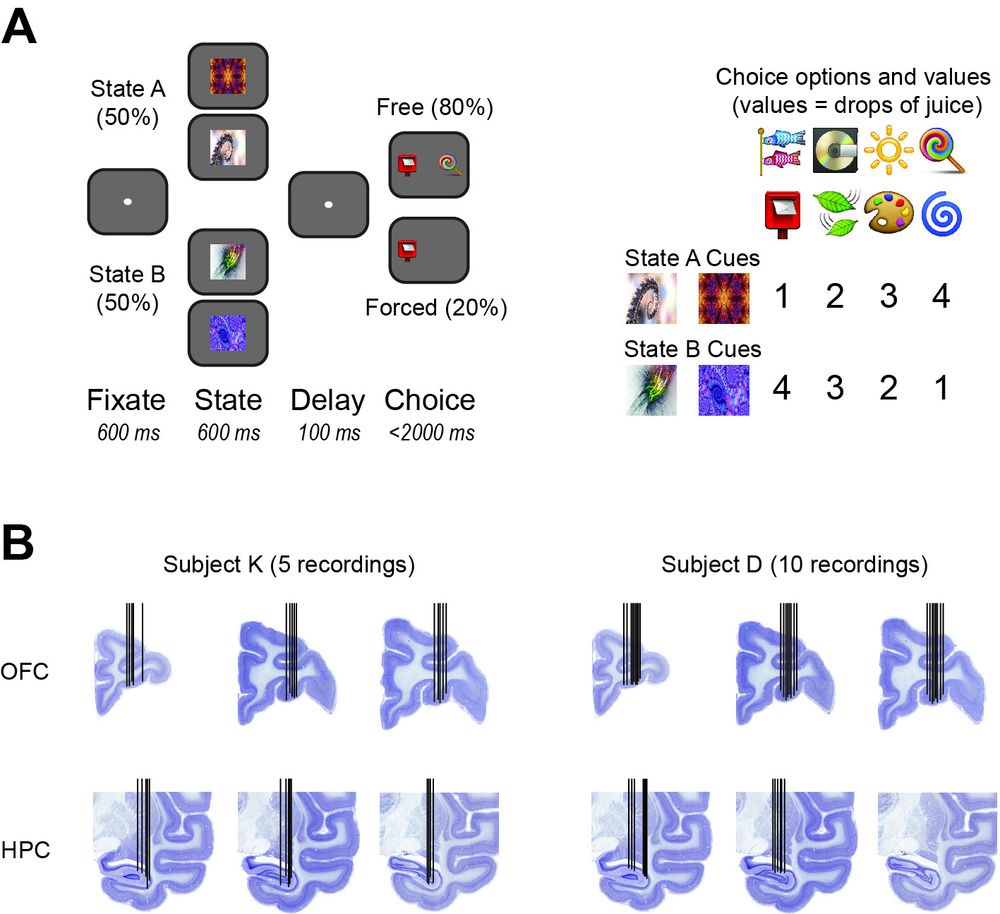
To address this, I recorded from HPC and OFC in two non-human primates (NHPs) performing a state-dependent choice task. On each trial, the NHPs were cued as to which of two value schemes to apply to an array of 8 choice options. The task state changed trial-to-trial. [3/n]
10.09.2023 00:54 — 👍 0 🔁 0 💬 0 📌 0Hippocampus (HPC) and orbitofrontal cortex (OFC) have both been proposed to carry cognitive maps but their precise roles in intializing vs utilizing an internal world model is controversial. The goal was to understand how each region contributes to model-driven behavior. [2/n]
10.09.2023 00:54 — 👍 0 🔁 0 💬 0 📌 0What seems good in one context might seem bad in another. Although we use contextual reasoning everyday, how the brain does this has remained unclear. Cognitive map theory offers a suggestion: the brain carries flexible, internal models of the world.
10.09.2023 00:51 — 👍 0 🔁 0 💬 0 📌 0
Hey bluesky - I'm happy to share a new preprint! I found that hippocampal-prefrontal interactions enable contextual reasoning in primates! Here's to hoping this thread works 🤞
www.biorxiv.org/content/10.1...